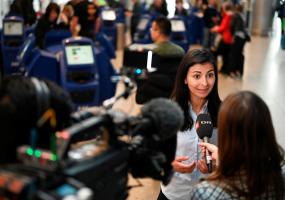Social media and protests in Turkey - seminar report
01 Mar 2016
By Servet Yanatma
Turkey’s ruling Justice and Development Party (AKP) has dramatically increased its suppression of the media, so you would imagine that the country’s social media have grown in importance. Digital consultant Esra Dogramaci’s main argument was that a nuanced understanding was necessary and that social media were less significant than one may suppose. She used the metaphor of “relationship status” of Facebook in order to explain the position of social media. She described it as similar to the “It’s complicated” option. The reason is that on the one hand, social media in Turkey are very popular with some groups in society; some people are very active; and it is a popular platform for sharing everything and consuming news. However, she pointed out that while 35 million of 77 million Turkish people have access to internet, and the number of Facebook users is around 30 million, only 6 million (or 8 per cent of the population) uses Twitter, and these are concentrated in urban populations. Tweets do not reflect what is happening in large areas of the country, where support for the AKP is strong. Dogramaci gave details of the Gezi Park Protests in Istanbul in 2013 to illustrate how social media, and particularly Twitter, did play an important role in organising the protesters. The Gezi protests erupted in late May 2013 over the AKP government’s plan to flatten Gezi Park near Taksim Square. What began as a peaceful demonstration against the government plan to uproot trees to build a shopping mall on the site of Gezi Park, a green space in central Istanbul, spiralled into protests against then-Prime Minister and current President Recep Tayyip Erdoğan’s government, particularly after a brutal police crackdown on peaceful protesters on May 31. The police force was criticized for excessive violence during the protests, including by Deputy Prime Minister Bulent Arinc. However, Erdoğan praised the crackdown, saying the police suppression of the protest had been “heroic”. The protests were the biggest incident of unrest against a government in the history of the Turkish Republic and the first serious challenge to Erdoğan’s rule. They caused a deeper divide in the already polarized nation. Dogramaci reminded the audience that the term “Turkish Spring” has been used by some observers to describe the protests simply because of the fact that protests came after the start of Arab Spring, but there were important differences. She pointed out that protests in Turkey mostly took place in Istanbul and were prompted by the desire to save a park but then it turned into “anti-Erdogan and anti-AKP sentiment” whereas people in Tunis, Egypt and Jordan came to the streets to protest the decades-old authoritarian rule in their countries. She explained that social media indeed became popular during the protests in part because several mainstream television channels did not cover them. For example, CNN international largely covered the protests, whereas CNNTürk, the Turkish version, broadcast a documentary of penguins instead of the events. Dogramaci also underlined that the reports from international media talking of the “massive protests against the Turkish government” were misguided as they were not strong nationwide. She pointed out that tweets were mainly coming from just three cities in Turkey, namely Istanbul, Ankara and Izmir. Although Twitter was important in mobilising a certain sector of the population during the protests, an analysis of Twitter alone cannot explain the nationwide state of political sentiment across the whole country. As she pointed out, the AKP won the elections by getting more than 49 per cent of votes that took place on November 1, 2015. “We can say that half of the country does support President Erdoğan and AKP,” Dogramaci said.
Esra Dogramaci, digital consultant, BBC World Service Digital and Technology group, spoke at the Business and Practice of Journalism seminar at Green Templeton College on Wednesday January 20, 2016.


